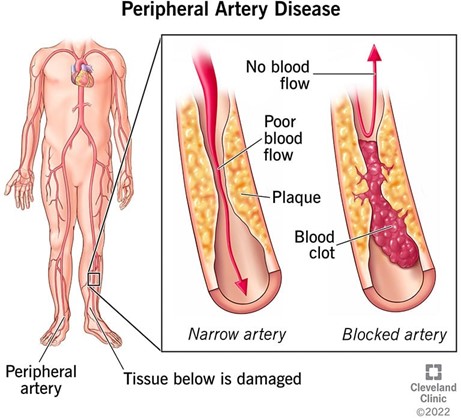A nurse is providing instructions about foot care for a client who has peripheral arterial disease.
The nurse should identify which of the following statements by the client indicates an understanding of the teaching.
"I rest in my recliner with my feet elevated for about an hour every afternoon.".
"l apply a lubricating lotion to the cracked areas on the soles of my feet every morning.".
"I soak my feet in hot water before trimming my toenails.".
"I use my heating pad on a low setting to keep my feet warm.".
The Correct Answer is B
The correct answer is: b. “I apply a lubricating lotion to the cracked areas on the soles of my feet every morning.”
Choice A reason: Elevating the feet for long periods is not generally recommended for clients with Peripheral Arterial Disease (PAD). This is because elevation can decrease arterial blood flow to the feet, which is already compromised in PAD. The goal is to promote blood flow to the extremities, and elevation might work against this, especially if done for extended periods.
Choice B reason: Applying a lubricating lotion to the feet, particularly on the soles where the skin can become very dry and cracked, is beneficial for someone with PAD. It helps to maintain skin integrity and prevent skin breakdown, which can lead to serious complications due to the reduced blood flow and healing capacity in PAD.
Choice C reason: Soaking the feet in hot water is not advisable for individuals with PAD. They may have reduced sensation in their feet due to poor circulation, which increases the risk of burns from hot water. Additionally, prolonged soaking can lead to maceration of the skin, making it more susceptible to injury and infection.
Choice D reason: Using a heating pad, even on a low setting, to keep the feet warm is risky for clients with PAD. Due to decreased sensation from poor circulation, there is a danger of burns because the client may not feel how hot the heating pad is. It’s better to wear warm socks or use room temperature control to keep the feet warm.

Nursing Test Bank
Naxlex Comprehensive Predictor Exams
Related Questions
Correct Answer is B
Explanation
The nurse should attend to the client who has thrombocytopenia and reports a nosebleed first.

Thrombocytopenia is a condition characterized by low platelet count, which increases the risk of bleeding.
A nosebleed can be a sign of significant bleeding, and it is important for the nurse to assess the severity and take appropriate action to stop the bleeding and prevent further complications.
Although the other clients also require nursing care, their conditions are not as urgent as the client with thrombocytopenia and a nosebleed.
The client with chronic obstructive pulmonary disease and an oxygen saturation of 89% may require oxygen therapy or other interventions to improve respiratory function, but the situation is not immediately life-threatening.
The client with left-sided paralysis and slurred speech from a prior stroke may require ongoing care and rehabilitation, but there is no indication of an acute change in their condition.
The client with multiple sclerosis and ataxia and vertigo may require assistance with mobility and balance, but their symptoms do not pose an immediate threat to their health.
Correct Answer is D
Explanation

White rice is a low-potassium food that can be recommended for a client who has chronic kidney disease and must limit potassium intake.
Nonfat yogurt (choice A) contains moderate amounts of potassium and may not be the best choice for someone who needs to limit their potassium intake.
A medium baked potato with skin (choice B) is high in potassium and should be limited to a low-potassium diet.
Peanut butter (choice C) also contains moderate amounts of potassium and may not be the best choice for someone who needs to limit their potassium intake.
Whether you are a student looking to ace your exams or a practicing nurse seeking to enhance your expertise , our nursing education contents will empower you with the confidence and competence to make a difference in the lives of patients and become a respected leader in the healthcare field.
Visit Naxlex, invest in your future and unlock endless possibilities with our unparalleled nursing education contents today
Report Wrong Answer on the Current Question
Do you disagree with the answer? If yes, what is your expected answer? Explain.
Kindly be descriptive with the issue you are facing.
